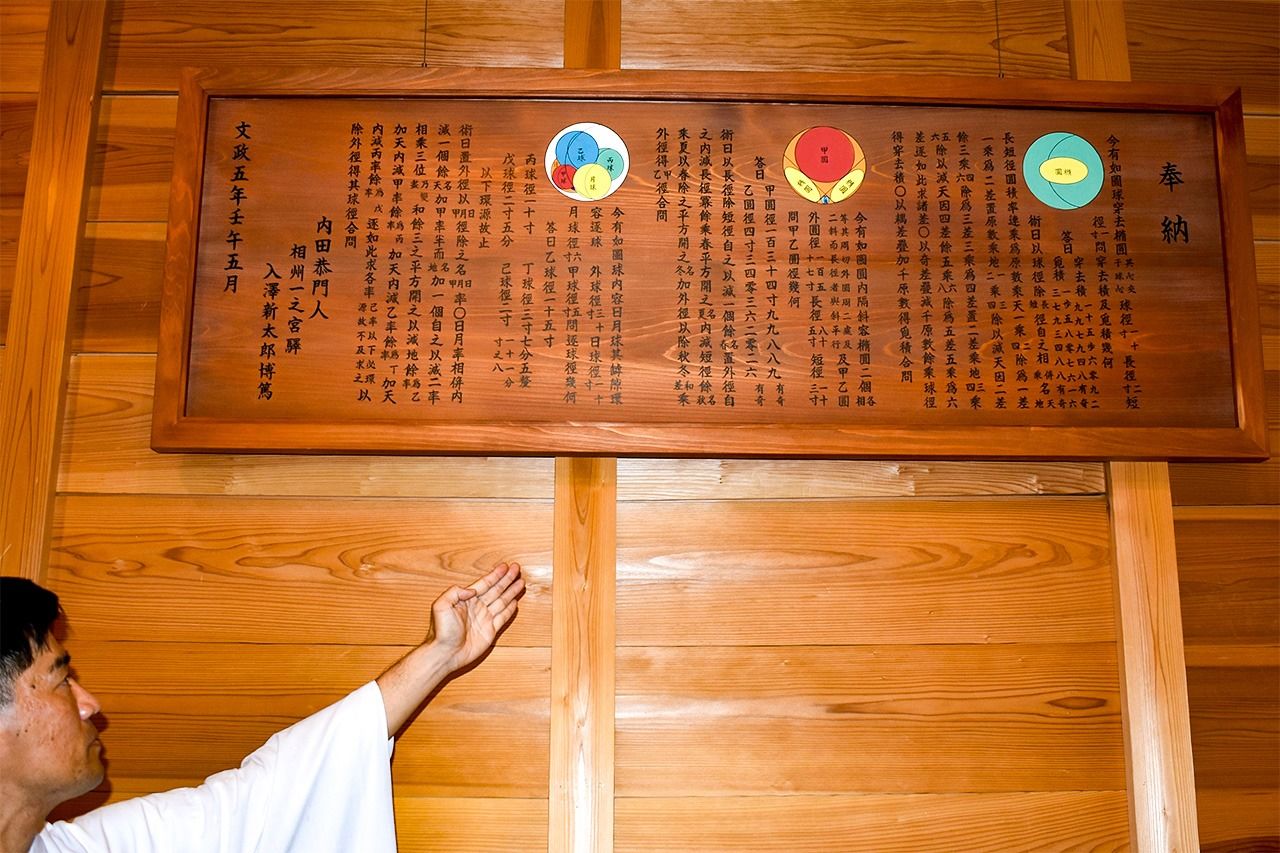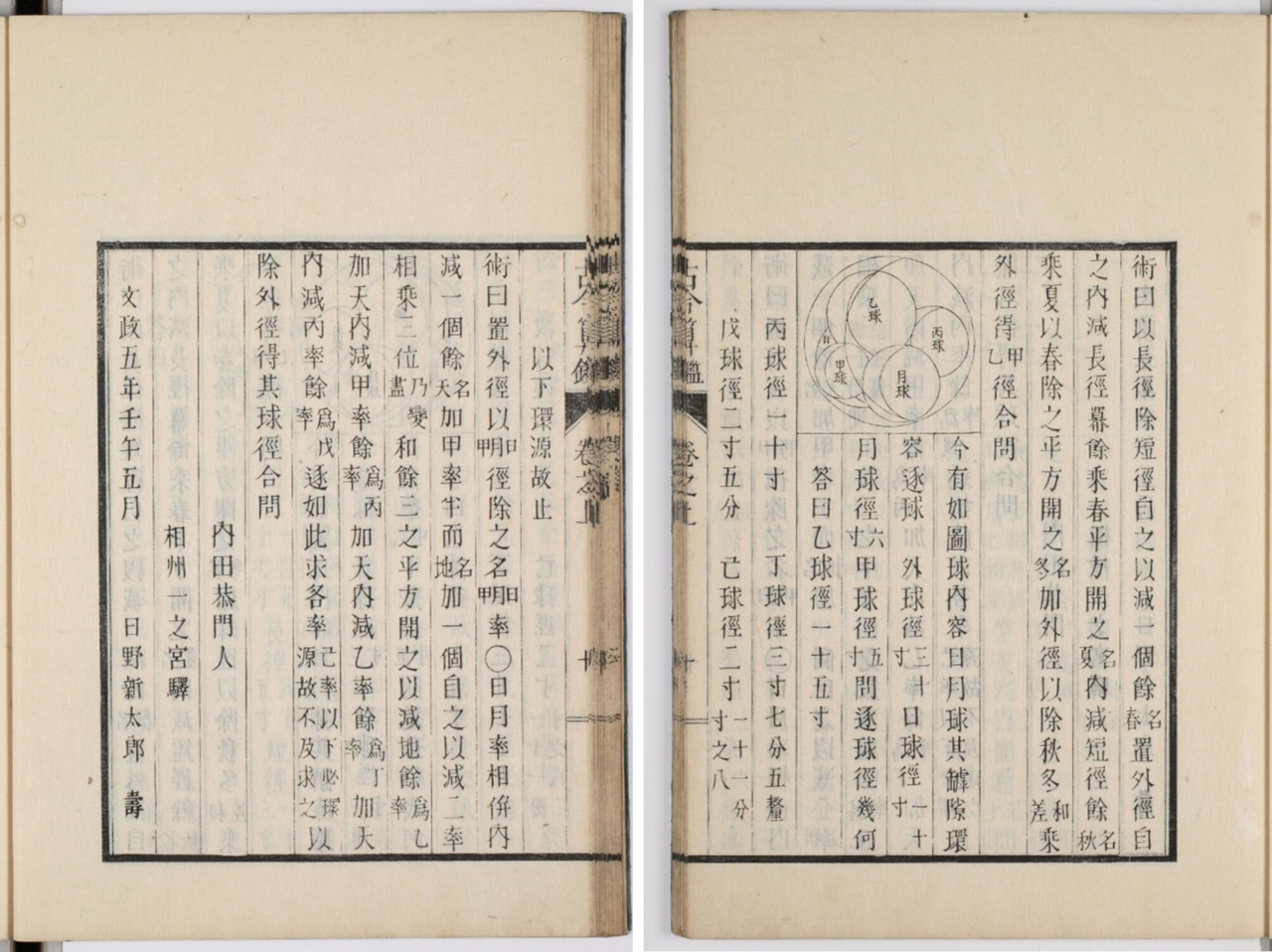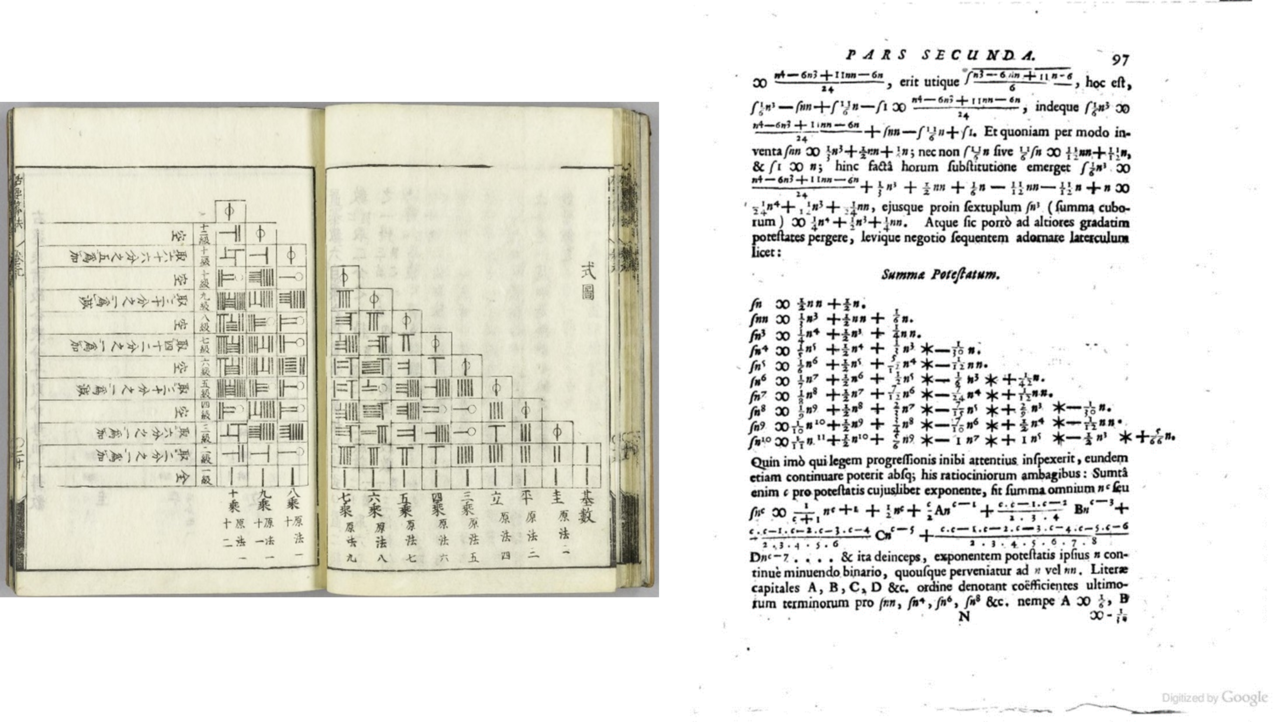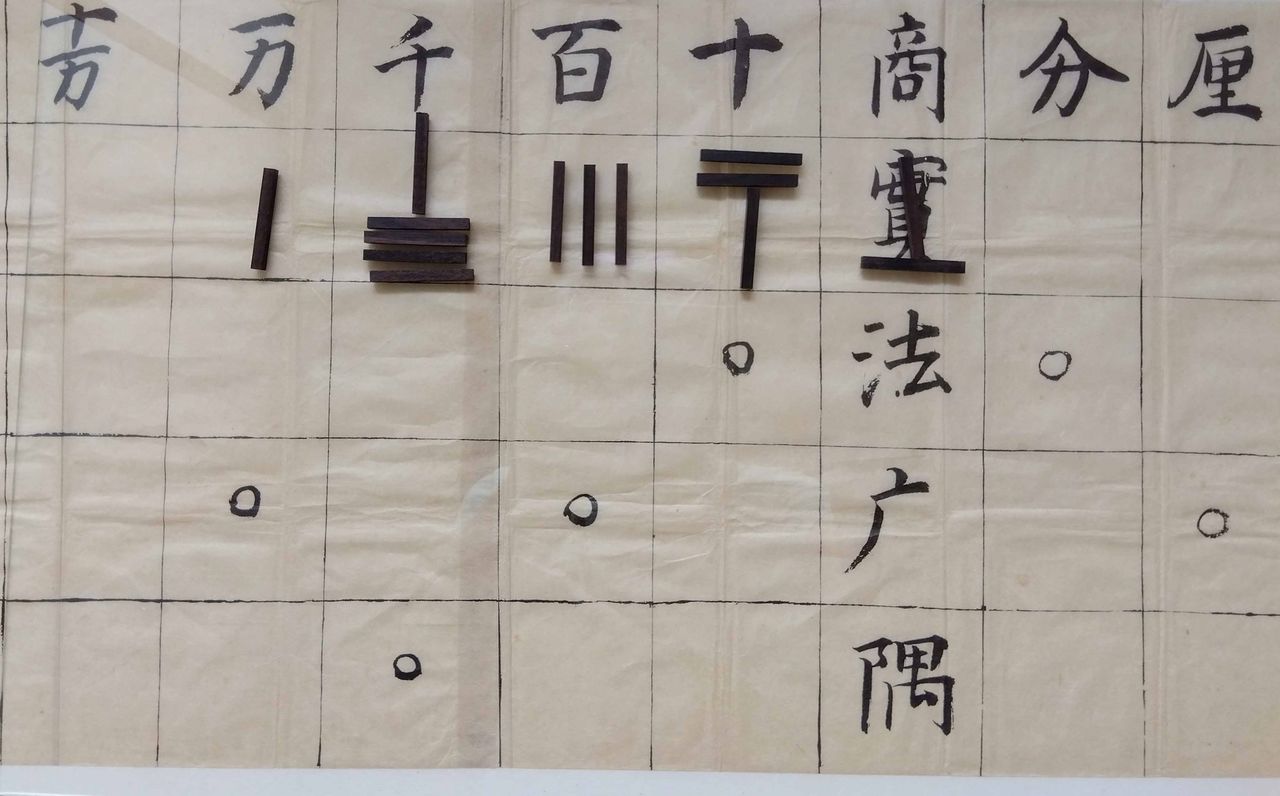
Classical Calculations: Japan’s Edo-Period “Wasan” Tradition of Mathematics
Japan’s “Wasan” Mathematical Tradition: Surprising Discoveries in an Age of Seclusion
Education Science History Culture- English
- 日本語
- 简体字
- 繁體字
- Français
- Español
- العربية
- Русский
One weekend in September 2023, I headed to Ōgaki Station in Gifu Prefecture to meet Peter Wong, Philips Professor of Mathematics at Bates College in Massachusetts. We had made plans to visit the temple Myōjōrinji in the city of Ōgaki to see the sangaku in its collection.
Sangaku are a kind of ema, wooden plaques that are typically donated to temples or shrines by people hoping for assistance with some personal challenge or trial. What sets sangaku apart from other ema is that each one commemorates—and offers a proof of—a newly discovered solution to a difficult problem in wasan, the Japanese tradition of mathematics that developed in the Edo Period (1603–1868). Along with contemporary documents, sangaku are invaluable historical resources that let us trace the development of wasan over the centuries. Around a thousand sangaku are known to survive inside Japan today. Wong, a specialist in topology, is a dedicated sangaku researcher. This was his seventh visit to Japan, and he planned to spend three weeks in total visiting various locations to see locally preserved sangaku and meet with wasan researchers.
Wong is far from the only researcher from outside Japan to have become fascinated by sangaku. Three unique characteristics explain this level of interest: the high level of achievement that wasan reached in isolation; the fact that sangaku were written by people from all walks of life, including women and children; and the geographical diversity of the phenomenon, with sangaku donated both in major cities and rural areas.
The Hexlet Theorem a Century Ahead of Its Time
In issue 138 of the prestigious scientific journal Nature, published in 1936, the British chemist Frederick Soddy published a poem called “The Hexlet.” This was the first appearance of what would later be known as “Soddy’s Hexlet Theorem,” describing certain relationships between a string of six connected spheres.
To ensure accuracy, let me introduce the details of the theorem and the story behind its discovery as it is explained in Sacred Mathematics: Japanese Temple Geometry, a book coauthored by Fukagawa Hidetoshi, a wasan researcher and former high school mathematics teacher who received a PhD from the Bulgarian Academy of Sciences, and theoretical physicist Tony Rothman, who has taught at Harvard and other institutes of higher learning.
Adapting Fukagawa’s and Rothman’s summary, the theorem is as follows: If two spheres of radii a and b lie inside a large sphere of radius r, touching each other and the sphere r internally, a necklace of exactly six spheres—each touching its nearest neighbors as well as spheres a, b, and r—can be created around the “neck” between spheres a and b. Furthermore, with the radii of the necklace’s spheres expressed as r1, . . . r6, then 1/r1 + 1/r4 = 1/r2 + 1/r5 = 1/r3 + 1/r6.
As a chemist investigating ion bonding, Soddy was interested in “packing problems” exploring how many cylinders and circles of different radii could fit inside the bounds of larger circles. He also worked with the New Zealand–born physicist Ernest Rutherford to discover nuclear transformation due to radioactive decay, and won the Nobel Prize in 1921 for “investigations into the origin and nature of isotopes.” All this goes some way to explaining why his name stuck to the hexlet theorem above.

A necklace of exactly six spheres can be constructed around the “neck” between spheres a and b. (© Nippon.com)
According to Fukagawa, whose research on sangaku has taken him across Japan, a man named Irisawa Shintarō Hiroatsu donated a plaque proving exactly the same result to Samukawa Shrine in Sagami Province (now Kanagawa Prefecture) in 1822. Irisawa was the descendent of merchants from Hino in Ōmi Province. He ran a store called the Hinoya that sold ingredients for traditional Chinese medical preparations, tea, and textiles, while pursuing wasan at the same time. Irisawa’s sangaku no longer exists, but its contents were recorded in an 1832 book called Kokon sankan (Mathematics, Past and Present) by wasan mathematician Uchida Itsumi. Uchida was Irisawa’s teacher, and Kokon sankan contained records of sangaku donated by his students.

A recreation of Irisawa’s sangaku based on the details in Kokon sankan, currently displayed at Samukawa Shrine. (Courtesy Abe Haruki)
The relevant pages from the digitally archived copy of Kokon sankan held by the Mathematical Library at Kyoto University’s Department of Mathematics are reproduced below. The statement of the problem starts in the fifth line of text from the right, and the solution is given immediately afterward.

Digital archive of Kokon sankan, Mathematical Library, Department of Mathematics, Kyoto University.
An English rendering of Fukagawa’s translation of the problem into contemporary Japanese might go as follows:
“As shown in the figure, place two spheres (“sun” and “moon”) inside a larger external sphere, such that both touch the external sphere’s inner surface, and then create a chain of connected spheres in the remaining space within the external sphere. If the diameters of the external, sun, and moon spheres are 30, 10, and 6 sun respectively, and the diameter of the sphere marked kō [lower right in the diagram] is 5 sun, find the diameters of the other spheres.”
The answer gives the diameters of the remaining spheres in order, starting from the one marked otsu, at the top of the diagram. After the sixth sphere, the solution ends with “at the seventh sphere, we return to the beginning, ending the problem.” In other words, the “seventh” sphere is actually the first sphere again—a perfect hexlet.
Thus, a theorem sought and elucidated as part of the research of a Nobel Prize winner was actually discovered by a Japanese merchant a century earlier. It feels inadequate to describe this kind of intellectual curiosity as a mere hobby. In any case, this was the intellectual energy among Japan’s everyday populace that supported wasan as an intellectual pursuit.
A Japanese “Mathematical Saint” Beats Leibniz to the Determinant
Seki Takakazu is an unavoidable figure in any discussion of wasan. Just as Matsuo Bashō is known as the haisei (“haiku saint”) and Sen no Rikyū as the chasei (“tea saint”), Seki was dubbed the sansei, or “mathematical saint,” for his monumental place in the field. The greatest mathematician wasan ever produced, Seki was born to the samurai class around 1640 and died in 1708, making him a contemporary of Isaac Newton (1642–1727) and Gottfried Leibniz (1646–1716), both of whom worked to develop and systematize calculus. Seki’s position as a treasury official for the Kōfu han, held for many years, made him a kind of professional mathematician.
The list of Seki’s accomplishments is long and includes solutions to many then-open problems in wasan, but what deserves the most attention is his adoption of the concept of the determinant and his discovery of Bernoulli numbers. During his life, Seki published only one book, the Hatsubi sanpō (Detailed Mathematics), but after his death his disciples published the four-volume work Katsuyō sanpō (Collection of Important Mathematical Results; 1712) and circulated numerous manuscripts recording his results.
Seki divided the problems and equations of wasan into three categories, “visible,” “obscure,” and “concealed,” each of which was to be approached in the appropriate way. “Visible” problems were those amenable to the standard arithmetical operations (addition, subtraction, multiplication, and division). “Obscure” problems were those involving equations with one unknown variable, and “concealed” problems had two or more unknown variables. Seki’s approach to “concealed” problems includes a combination of operations he refers to as “interchange” and “cross-multiplication” (kōshiki and shajō, respectively), which effectively involve extracting a determinant. Seki reportedly shared this method in 1683.
Meanwhile, Leibniz describes hitting on the idea of the determinant in a 1693 letter to the French mathematician Guillaume de l’Hôpital, but the details are obscure. It was not until 1846 that French mathematician Pierre F. Sarrus actually published a method for calculating third-order determinants in the same way as Seki. In any case, we can see that Seki’s adoption of the determinant concept predated Leibniz by at least a decade.
Even those who struggled with mathematics and shudder at the thought of another encounter with simultaneous equations should be able to recognize Seki’s genius in the image below. These diagrams are from the pages in the Japan Academy’s copy of Kaifukudai no hō (Method of Solving Hidden Problems) that explain “interchange” and “cross-multiplication.” The procedure is exactly the same as the “Sarrus method” taught in contemporary mathematical textbooks.

Methods for extracting a determinant.
I want to avoid restricting the discussion entirely to questions of priority, but let us consider one more example of Seki “getting there first”: the so-called Bernoulli numbers. You can think of these as a series of special numbers used in finding the solutions to sums like 1 + 2 + 3 + . . . , 12 + 22 + 32 + . . . , 13 + 23 + 33 + . . . , and 1k + 2k + 3k + . . . in general.
Bernoulli numbers are not only still used today in such calculations, they have since been found to have connections to many other areas of mathematics. They were given the name “Bernoulli numbers” because they were first clearly elucidated by Swiss mathematician Jakob Bernoulli, in a 1713 work called Ars Conjectandi.
Seki’s discovery of the series is recorded in Katsuyō sanpō, in a section called “Daseki jutsu,” or “Technique for finding sums of powers.” This book was published in 1712—one year before Ars Conjectandi.
During Seki’s lifetime, the strict border control policies of the Edo shogunate cut off almost all communication with the outside world. Nevertheless, Seki and Bernoulli clearly arrived at the truth by following the same approach.

“Daseki jutsu” in Katsuyō sanpō (courtesy National Diet Library Digital Archive) beside Ars Conjectandi (courtesy Internet Archive).
Solving Equations of Higher Order
Seki and his successors arrived at many unique mathematical truths other than those described above, sometimes ahead of European mathematicians and sometimes behind. To list a few by name only, these include Descartes’ theorem, Malfatti circles, Taylor expansions, increasingly accurate calculations of pi, approximate solutions to higher-order equations, and more. Seki’s esteemed disciple Takebe Katahiro calculated pi to 41 decimal places, and one wasan mathematician reportedly sought an approximate solution to an equation of the 1,458th degree. All of these accomplishments were made possible by the use of sangi and sanban, respectively “calculating sticks” and the “calculating sheet” on which they were arranged, creating a kind of protocomputer that wasan mathematicians manipulated by hand.

Sangi three to five inches long were arranged in the cells of a sanban to represent numbers. This image shows the digits “19376.” (Courtesy Fukagawa Hidetoshi)
In Japan, wasan is still generally misunderstood as only reaching about the level of elementary school arithmetic, and my list of wasan “world-leading discoveries” above is partly intended to break down that prejudice. What I truly wish were more widely known, however, is the fact that even during Japan’s years of isolation, its people took pleasure in pushing mathematics forward.
Let us give the last word to Professor Wong, whom we met in the first paragraphs of this article. Wong is of Chinese descent, and he offered a comment on the development of wasan that makes a powerful impression:
“Look at China and the other Asian countries. Japan is the only place where the common folk were spared from war for 260 years. The people of Japan had the good fortune to be able to concentrate on cultural pursuits instead.”

A sangaku donated to Isobe Shrine in Sabae, Fukui, posing a problem about how much sake each attendee at the flower-viewing party drinks. (Courtesy Isobe Shrine)
(Originally published in Japanese. Banner photo: Professor Peter Wong examining the sangaku at Myōjōrinji. © Abe Haruki.)
